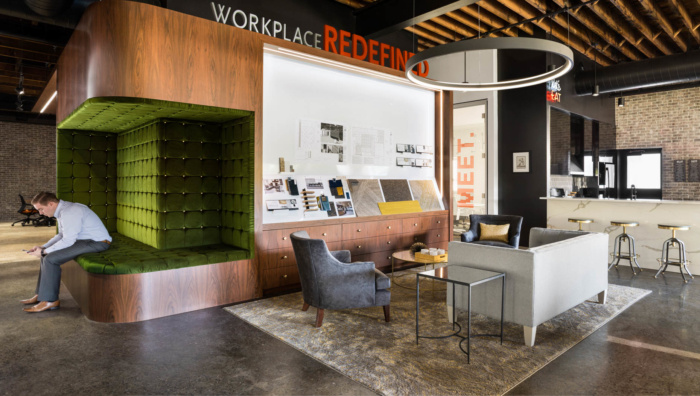
The Intro: Getting to Know Studio Eagle
Studio Eagle is a workplace design firm located in Springfield, New Jersey. As a reader of Office Snapshots you may be familiar with their work for MC², Kumon North America, ControlTek, and Filippo Berio.
We recently had the chance to hear from a variety of leadership voices to learn more about their history, what makes them tick, their design process, and how they strive to redefine the workplace one office at a time.
We understand you went through a rebrand nearly three years ago this upcoming summer. During that process, how did the name Studio Eagle come to be? Can you tell us a little bit about the story and evolution of the firm?
Amanda Markham – Administrative Director: Our company first opened its doors in 1987 with the name Eagle Acoustics, focusing on suspended ceilings and interior construction. We grew from this small construction company, becoming a furniture dealer in the 1990s, and evolving into a mid-size design and construction firm.
Bruce Emtage – Managing Director: As we grew, so did our brand. Always identified as Eagle, our brand reflects this growth. Today as Studio Eagle, we are a leading architectural and design studio consistently redefining the workplace.
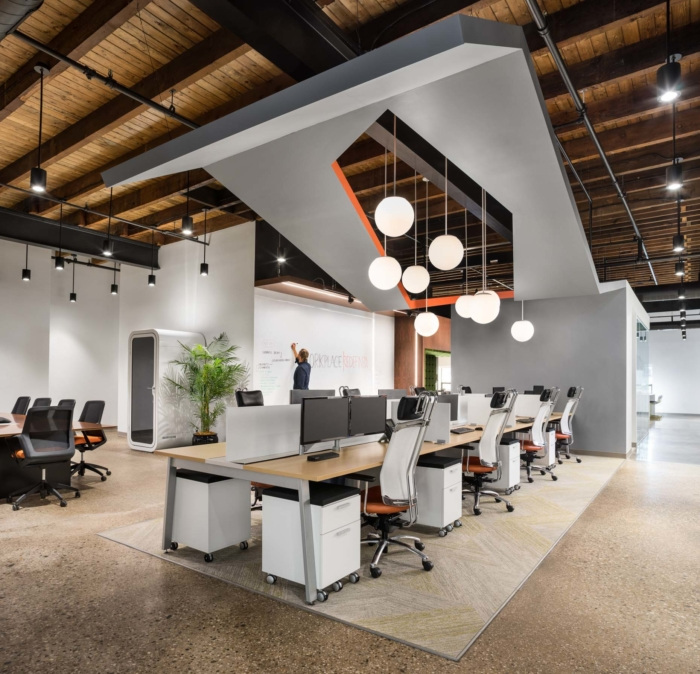 © Trent Bell
© Trent BellAbove: Studio Eagle
It’s clear Studio Eagle HQ has its roots in the Garden State. Can you give us a feeling for what the office design landscape is like in the Greater New York City area? Where do Studio Eagle’s designs fit in and how do they exceed what might be expected?
Cody Baldwin – Design Director: With uncertainty in the global markets, we are seeing a lot of international companies looking to establish headquarters in New York and New Jersey where the markets are seen to be stable. What we have found is that these headquarters also want to be close to the incredible talent pool we have in our tri-state area. Today, companies are continuing to push for flexible and unique work environments with a combination of building and in-suite amenities to attract and retain this top talent.
Aneta Stepien – Designer/Furniture Specialist: Following off what Cody said, with our integrated approach of Far-Sighted Strategy, Design-Driven Solutions, and Risk-Free Integrated Delivery, our teams are really able to meet these needs and design priorities of our clients by maximizing the value of a project budget through progressive budgeting. What I continue to find really unique about working at our firm is we are truly a full service studio. With everything from furniture dealer capabilities and architectural designers, to strategists and construction managers, we are all constantly collaborating to exceed what might be expected.
Let’s take a look at some of Studio Eagle’s most recent projects. How does designing a space for an olive oil company like Filippo Berio compare to an education company like Kumon North America, Inc.?
Aneta Stepien: From a designer point of view, the main difference I believe between our two projects here is the audience. The design of the Filippo Berio space was definitely an emphasis on creating a test kitchen for our client’s team to be able to use their products while also entertaining their clients and employees. We’re proud to say we were able to bring to life their rich Italian roots throughout their space. By translating their historical media to environmental graphics for example, we were able to even showcase the smallest detail of their heritage.
 © Mikiko Kikuyama
© Mikiko KikuyamaAbove: Filippo Berio
For Kumon North America, Inc., the scale and complexity in comparison to our Filippo Berio project was really completely different. We needed to weave all of the program elements into a cohesive design considering the audience of both families and office staff occupying space in the environment. Kumon’s space design was driven with a mindset of developing a positive, productive, and safe environment for all.
Cody Baldwin: Ultimately, although the scale or particular market sector for a project may differ greatly, as Aneta was touching on, our approach to every project remains the same. It starts with an in-depth analysis and understanding of the client’s unique cultural and programmatic needs. This is then used to craft thoughtful design solutions that meet our quality standards and the client’s strategic objectives.
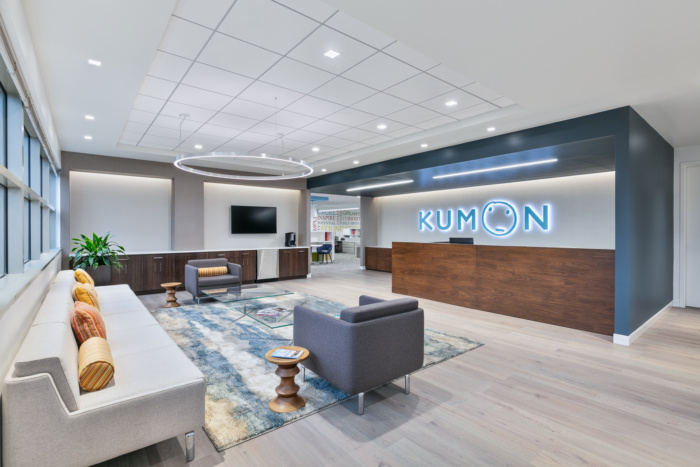 © Will Ellis
© Will EllisAbove: Kumon North America, Inc.
Thinking back to the strategic process of designing your own headquarters during the rebrand, how would you say designing an office for yourself compares to these most recent project experiences?
Mark Lo Bue – Workplace Strategy Director: It’s often said that it’s more challenging to design your own space than it is for another’s. As Cody was getting at, meeting strategic objectives is certainly top of mind from the onset of the process. The similarities of our strategy process is strong between what we conducted on our studio, and what we perform for our client’s own office spaces.
Beginning with department assessments, we identified the programming needs for each group in terms of quantities and types of workspaces, and collaboration and amenity requirements to determine a square footage requirement. Various degrees of adjacencies were then matched to these in understanding their location as it relates to the layout and the employees that will use them. For our studio, branding was a key design and communication element that we wanted to see throughout our space and one that I believe we’ve powerfully implemented for both our Kumon North America, Inc. and Filippo Berio projects as well.
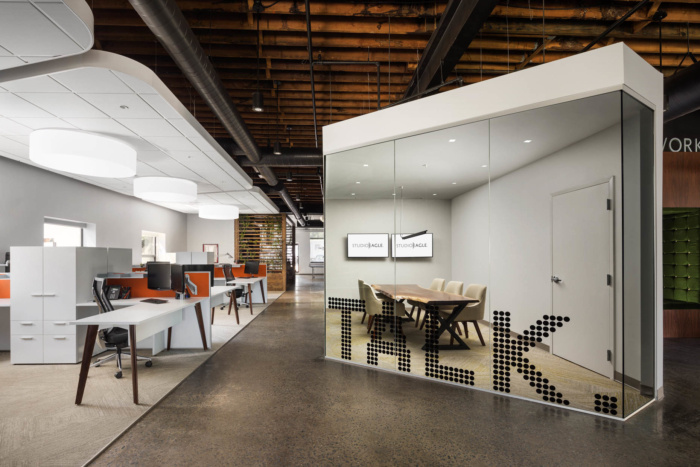 © Trent Bell
© Trent BellAbove: Studio Eagle
It sounds like branding plays a critical role in bringing to life a built environment. Based on your experience in the discipline, can you describe for us your ideal work environment?
Jess Spataro – Brand Director/Strategist Lead: Being a part of creating workspaces that can allow for personal journey, speak to the vision of a company, and encourage a more thoughtful experience in our working lives, is what keeps me motivated to do what we do every day. My ideal working environment is centered around this meaningful story of how our environments can be creative engines helping people to produce their best work.
With a brand purpose at Studio Eagle to redefine the workplace, I find myself continuously fascinated with the human to space connection we have with our workplaces. From a variety of amenities and collaboration areas that bring our communities together, to outdoor spaces that invite nature and relaxation into our work day, it’s this flexibility and opportunity for choice we plan for that I think can make all the difference in a working environment.
As seasoned professionals in the Architecture, Engineering and Construction (AEC) industry, what would you say has changed in the field since you each began your careers?
Alyssa Wright – Construction Director: Since diving into Construction Management, I’ve found there has been a noticeable shift in the way we use technology to document and communicate with subcontractors, clients, and designers. Hardware in the field, coupled with software from the office, has been able to bridge the gap of communication from what is going on at the sites, and the information that is ultimately transferred back to the office in real time.
Randall Emtage – Project Director: Working closely every day with Alyssa out at site, I definitely agree with the shift and ease today to transfer communication for successful project delivery. The evolution of devices like tablets and cloud-based programs like PlanGrid, allow for the flow of information to happen more effectively and efficiently leading to less wait time for answers to questions and situations that develop on our job sites. We are now able to expedite and speed up our overall risk-free construction process.
Steve Lyons – Technical Manager: From the technical front and working closely with our design team, from my experience I’ve seen first hand how the use of 3D modeling software such as Revit and Building Information Modeling (BIM) has been leveraged to develop and bring to life our drawings. We use this information during the bidding process and really throughout the entire project process in order to further convey our design intent to subcontractors and field staff. We find that this added view of information is not only well received, but allows the working process to flow much smoother when our subcontractors know what the finished product should look like before the build even begins. As an added benefit before award and construction, and after having exposed our whole team including our subcontractors to the 3D design, we are now seeing fewer Requests for Information (RFIs) from the field and ultimately fewer change orders.
Looking ahead at what’s to come for Studio Eagle, could you share with us any new projects the firm is currently working on?
Bruce Emtage: We are thrilled to have just moved in to their new spaces two great clients – Octapharma USA and Fujitsu General America, Inc. These spaces are North American headquarters for both clients, and are a great representation of the future of both these companies and the successful organizations they are for their clients and staff. Our studio was honored to have been chosen amongst great design firms in the state to represent the industry in these two high-end build outs.
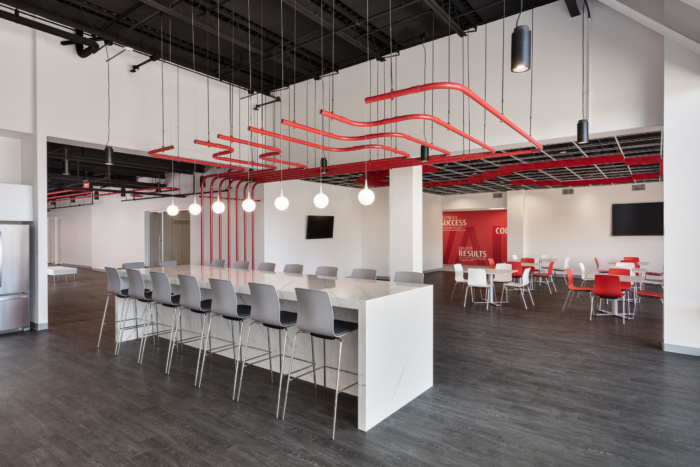 © Will Ellis
© Will EllisAbove: Fujitsu General America, Inc.
Given the current times of crisis, Studio Eagle has adapted to the challenges swiftly as we progress through. Our design team is currently working hard remotely on the documents for IAT Insurance Group, Inc.’s Newark, NJ office, a brand new office for QE Solar in town, the assistance of the concept and feasibility of a new customer center for Voyant Beauty, LLC, lounge and employee areas for Henry Schein, and much more!
Our construction teams are also fully operational as the state allows during these times. With this, our team is thrilled to soon commence on a new physical therapy center inside of Wakefern Food Corporation’s headquarters in Edison, NJ. The agility of our teams at Studio Eagle has allowed us to stay fully operational during this very difficult time for our world, and we are committed everyday to helping our clients through it under the governmental regulations.
You can connect with Studio Eagle on their website, on Instagram or LinkedIn, and browse their projects on Office Snapshots.


























